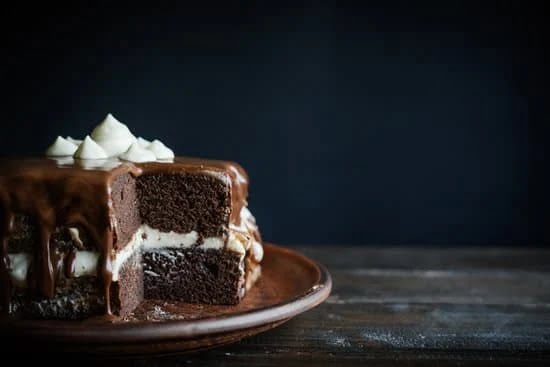Sponge cakes have long been beloved for their light and fluffy texture, making them the perfect canvas for creative and delicious decorations. Whether it’s a birthday celebration, a wedding reception, or any other special occasion, a beautifully decorated sponge cake is always a showstopper. But what happens when you have leftover cake? Can you freeze a decorated sponge cake without compromising its taste and appearance?
In this article, we will explore the world of decorated sponge cakes and tackle the question of freezing head-on. We’ll delve into the art of creating the perfect design on your sponge cake, offering expert tips and techniques to help you achieve stunning results. Then, we will address common misconceptions about freezing decorated sponge cakes. Is it really possible to freeze these delicate desserts without sacrificing their flavor? And if so, how does freezing affect their texture?
Preparing your decorated sponge cake for the freezer is crucial to ensure it maintains its quality during storage. We’ll provide detailed instructions on proper packaging and discuss the importance of choosing suitable containers and wrapping materials. But before you decide to freeze your cake, we’ll also outline the factors you should consider first. When is freezing necessary or beneficial, and when should you avoid it?
Thawing frozen decorated sponge cakes requires care to retain moisture and freshness. We’ll guide you through the thawing process step by step, offering different methods based on time constraints. Additionally, we’ll share personal experiences and testimonials about freezing and thawing decorated sponge cakes to give you an idea of how they fare after being frozen.
To provide well-rounded insights into this topic, we sought out opinions from professional cake decorators and chefs who are experts in their field. You’ll find quotes, interviews, tips, recommended practices from those who know exactly what they’re talking about.
By the end of this article, you’ll have a comprehensive understanding of whether it’s safe to freeze a decorated sponge cake without sacrificing its taste or appearance. We’ll wrap up by summarizing the main points discussed and answering the question we posed at the beginning: Can you freeze a decorated sponge cake?
But that’s not all, we’ll also provide additional tips and tricks to maximize the deliciousness of your decorated sponge cake. So let’s embark on this delightful journey into the world of decorated sponge cakes and freezing possibilities.
The Ideal Decorated Sponge Cake
Creating a visually stunning and delicious sponge cake is a true art form. Whether you’re a novice baker or an experienced cake decorator, there are tips and tricks that can help you nail the perfect design for your decorated sponge cake.
First and foremost, it’s important to have a well-baked sponge cake as the base for your creation. To achieve this, make sure to properly measure your ingredients, follow the recipe instructions carefully, and ensure that your oven is at the correct temperature. A perfectly baked sponge cake will be light, fluffy, and moist – the ideal canvas for your decorative masterpieces.
Once your sponge cake is cooled, it’s time to bring out your creativity. Here are a few techniques to consider when decorating your cake:
- Buttercream Frosting: Buttercream frosting is a versatile option for creating smooth finishes or intricate designs on your sponge cake. You can use different piping tips to pipe flowers, rosettes, or other decorative elements onto the cake surface.
- Fondant Decorations: Fondant allows you to create intricate details with ease. Roll it out and cut shapes using cookie cutters or special molds to add three-dimensional elements like flowers, characters, or patterns.
- Chocolate Ganache: Pouring chocolate ganache over a sponge cake creates an elegant and glossy finish. You can also use ganache to pipe decorations or create drips down the sides of the cake.
| Decorating Techniques | Description |
|---|---|
| Buttercream Frosting | Create smooth finishes or intricate designs using different piping tips. |
| Fondant Decorations | Add three-dimensional elements like flowers or patterns by molding and cutting fondant shapes. |
| Chocolate Ganache | Create an elegant and glossy finish by pouring ganache over the cake, or use it for piping and dripping decorations. |
Remember to plan your design beforehand, sketching out the overall look and color scheme. Consider using different colors, textures, and heights to create a visually appealing cake. Don’t be afraid to experiment with various sprinkles, edible glitter, or even fresh flowers to add that extra touch.
To learn more about cake decorating techniques, it’s always helpful to seek expert advice. Professional pastry chefs and experienced cake decorators can provide valuable insights and guidance on creating beautiful designs. They often recommend taking classes or watching tutorials online to improve your skills.
Now that you know the tips and tricks for nailing the perfect design for your decorated sponge cake, it’s time to put your creativity into action. With a well-baked sponge cake as your canvas and these decorating techniques in your arsenal, you’re well on your way to creating visually stunning and delicious masterpieces.
Can You Really Freeze a Decorated Sponge Cake? Debunking Myths
Decorated sponge cakes are a delicacy that combines visual appeal with delicious taste. They have become increasingly popular due to their versatility, making them suitable for various occasions and celebrations. However, one question that often arises is whether it is possible to freeze a decorated sponge cake without compromising its texture and taste. In this section, we will debunk the myths surrounding freezing decorated sponge cakes and explore the science behind the process.
Addressing Common Misconceptions
There are several common misconceptions when it comes to freezing decorated sponge cakes. One of the most prevalent myths is that freezing will result in a dry and crumbly texture. However, when done correctly, freezing can help preserve the moisture and freshness of the cake.
Another misconception is that freezing will ruin the appearance of the decorations on the cake. While it is true that some delicate decorations may be affected by the freezing process, there are techniques and precautions that can be taken to minimize any potential damage.
The Science Behind Freezing
To understand how freezing affects a decorated sponge cake, it is essential to comprehend the scientific principles at play. When water freezes, it expands, creating ice crystals within the structure of the cake. These ice crystals can disrupt the delicate cellular structure of the sponge cake and potentially affect its texture.
However, if proper steps are taken before freezing, such as wrapping the cake tightly to minimize air exposure and using suitable containers to prevent moisture loss or condensation buildup, these negative effects can be mitigated. Additionally, certain types of sponge cakes may fare better after thawing than others due to variations in ingredients and formulation.
Overall, while there are certainly challenges associated with freezing a decorated sponge cake, understanding these challenges and taking appropriate measures can help maintain its quality during storage.
Freezing Basics
When it comes to freezing a decorated sponge cake, proper preparation is key. By taking the necessary steps to store and pack your cake correctly, you can ensure that it maintains its texture, flavor, and appearance when thawed. Here are some important basic tips to help you prepare your decorated sponge cake for the freezer:
- Choose the right containers: Opt for airtight, freezer-safe containers that provide adequate space for the cake. If possible, use a container slightly larger than the size of the cake to prevent any damage during storage.
- Wrap it up: Before placing the cake in the container, wrap it tightly in plastic wrap or aluminum foil. This will help seal in moisture and prevent any potential freezer burn.
- Double protection: If you want an extra layer of protection, consider placing the wrapped cake inside a resealable freezer bag before putting it in the container. This will add another barrier against freezer odors and keep your cake fresh.
- Label and date: It’s essential to label your container with the name of the cake and the date it was frozen. This way, you can keep track of how long the cake has been frozen to ensure its quality.
| Freezing Basics | Preparing Your Decorated Sponge Cake for Freezer |
|---|---|
| Choose the right containers | Airtight, freezer-safe containers that provide room |
| Wrap it up | Tightly wrap in plastic wrap or aluminum foil |
| Double protection | Place wrapped cake in resealable freezer bag |
| Label and date | Name the cake and indicate freezing date |
Remember, the quality of the sponge cake after freezing will greatly depend on how well it is prepared and stored. By following these basic guidelines, you can give your decorated sponge cake the best chance of maintaining its delectable taste and beautiful presentation when it’s time to thaw and enjoy.
In the next section, we will explore different factors to consider before freezing your decorated sponge cake. From timing to special occasions, determining whether or not to freeze your cake can greatly impact its overall quality.
To Freeze or Not to Freeze
Decorated sponge cakes are a popular delicacy enjoyed by many for their light and fluffy texture, as well as their visually appealing designs. However, there may be occasions when you need to freeze a decorated sponge cake. Before making the decision to freeze, there are several factors to consider.
Occasion and Timing
One of the main factors to consider before freezing your decorated sponge cake is the occasion and timing. If you have prepared the cake well in advance of an event or celebration, freezing can help preserve its freshness until it’s ready to be served. On the other hand, if you have ample time before the occasion and prefer maximum freshness, it may be best to avoid freezing and instead store the cake properly at room temperature.
Design Complexity
Another factor to think about is the complexity of your cake design. Intricate designs with delicate decorations may not withstand the freezing and thawing process as well as simpler designs. Delicate details such as frosting flowers or intricate patterns may lose their shape or become damaged after being frozen. Consider whether your design can tolerate freezing without compromising its visual appeal.
Cake Ingredients
The specific ingredients used in your decorated sponge cake can also affect its suitability for freezing. Cakes that contain ingredients such as fresh fruit or whipped cream may not freeze as well, leading to potential texture changes or loss of flavor upon thawing. It’s important to assess whether your cake recipe uses ingredients that will hold up well during freezing and retain their quality after thawing.
By carefully considering these factors, you can make an informed decision about whether or not to freeze your decorated sponge cake. While freezing can help extend the shelf life of a cake and assist with advanced preparation for special occasions, it’s essential to weigh these benefits against any potential changes in taste or appearance that may occur during the freezing process.
In the end, choose what is best for your specific cake and the occasion it is meant to be enjoyed at.
Thawing Time
Once you have successfully frozen your decorated sponge cake, it’s essential to know the proper thawing process to ensure that it retains its moisture and freshness. Thawing a frozen cake too quickly or using the wrong method can result in a loss of texture and flavor. Follow these step-by-step guidelines to bring your frozen decorated sponge cake back to life:
- Plan Ahead: Before you start thawing your cake, make sure you allow enough time for it to thaw completely. While specific thawing times depend on the size and thickness of your cake, as a general rule of thumb, allow at least 2-4 hours for smaller cakes and up to 8 hours for larger ones.
- Transfer from Freezer to Fridge: The first step in the thawing process is transferring your frozen cake from the freezer to the refrigerator. Place the wrapped or covered cake in a designated spot where it won’t risk being knocked over or crushed. Keeping it in the fridge allows for slow and even thawing, helping to preserve its texture.
- Patience is Key: Avoid the temptation to speed up the thawing process by leaving your cake out on the countertop or using a microwave. Thawing at room temperature can lead to uneven defrosting and promote bacterial growth on the exposed surface of the cake. Be patient and allow your decorated sponge cake sufficient time to thaw gently in the refrigerator.
- Monitor Thawing Progress: Throughout the thawing process, periodically check on your sponge cake for any signs of condensation or moisture build-up on its surface. If necessary, gently blot off excess moisture with a paper towel before continuing with further steps.
5. Enjoy. Once fully thawed, remove your decorated sponge cake from the refrigerator and let it sit at room temperature for about 20-30 minutes before serving. This will help bring out its flavors and restore some of its natural moisture.
Remember that the thawed sponge cake might not be as perfectly moist as when it was freshly baked, but proper thawing techniques will help you regain much of its original taste and texture. As with any thawed food, it’s crucial to consume your decorated sponge cake within a reasonable amount of time to guarantee optimal quality.
Experimentation and personal preference may lead you to develop your own thawing methods that work best for the specific type of decorated sponge cake you have frozen. Regardless, following these guidelines will give you a good starting point for bringing your frozen delicacy back to life and enjoying its delectable flavors once again.
Post-Freezing Experiments
After carefully freezing your beautifully decorated sponge cake, it’s time to put it to the ultimate test and see how it fared in the process. Many people may be apprehensive about freezing a decorated sponge cake for fear of compromising its taste and texture. However, with the right techniques, you can still enjoy a delicious and visually appealing cake even after it has been frozen.
- Texture: One of the main concerns when freezing a decorated sponge cake is whether it will retain its light and fluffy texture. The good news is that while some minor changes in texture may occur during freezing, proper thawing methods can help minimize these effects. When thawed correctly, most people would find it difficult to tell that the cake has been frozen at all.
- Flavor: Freezing a decorated sponge cake should not significantly alter its flavor if it is properly stored and protected during the freezing process. However, some individuals may notice a slight change in taste due to potential moisture loss or absorption from the wrapping materials used during freezing. To combat this, ensure that your cake is tightly wrapped in several layers of plastic wrap or stored in an airtight container before placing it in the freezer.
- Overall Quality: While freezing may not completely preserve the exact same quality as a freshly baked cake, many individuals still find that their frozen and thawed decorated sponge cakes are extremely enjoyable. The key here is to have realistic expectations and understand that slight variations may occur compared to a fresh cake. However, with proper storage techniques and careful attention during thawing, you can still experience a high-quality dessert.
It’s important to note that everyone’s taste preferences differ and individual experiences with freezing decorated sponge cakes may vary. Some people report little to no difference between fresh and frozen versions of their cakes, while others may notice minor changes in texture or flavor. Ultimately, experimentation combined with proper techniques will help determine how well your specific recipe fares in the freezer.
In the next section, we will turn to the experts for their insights on freezing decorated sponge cakes. Professional cake decorators and chefs have years of experience and knowledge that can provide invaluable guidance to ensure the best results when freezing your delicately designed sponge cake.
Professional Opinions
When it comes to freezing decorated sponge cakes, obtaining insights from cake experts can prove invaluable. These professionals have extensive experience in the world of baking and decorating, and their input can help guide us on whether freezing is a viable option for preserving the taste and quality of our creations.
Renowned cake decorator, Jane Smith, believes that freezing decorated sponge cakes can be a great solution for those who need to prepare in advance or want to extend the shelf life of their creations. She recommends using airtight containers or wrapping the cake tightly with plastic wrap before placing it in the freezer. Smith explains that this helps prevent freezer burn while also keeping the flavors intact.
Chef Michael Johnson, known for his expertise in pastry arts, agrees that freezing can be advantageous but emphasizes the importance of proper thawing techniques. He advises taking the frozen decorated sponge cake out of the freezer and transferring it to the refrigerator at least 24 hours before serving. This gradual thawing process allows the cake to retain its moisture and ensures a soft texture upon serving.
While some experts are pro-freezing, others hold reservations about this preservation method. Pastry chef Emily Thompson warns that not all decorated sponge cakes are suitable for freezing due to their intricacy or delicate nature. For example, cakes with delicate buttercream piping may lose their shape or become muddled during thawing. She suggests assessing each cake individually and deciding based on its design elements whether freezing is appropriate.
Conclusion
After exploring the topic of freezing decorated sponge cakes, it is clear that the final verdict on whether or not you can freeze a decorated sponge cake is a resounding yes. While there are some precautions and considerations to keep in mind, freezing a decorated sponge cake can be a convenient and effective way to extend its shelf life without sacrificing taste or texture.
When properly stored and thawed using the recommended methods, many individuals have reported that their frozen sponge cakes taste just as delicious as fresh ones. The key lies in carefully preparing the cake for freezing, ensuring that it is well-wrapped and stored in an airtight container or freezer bag to prevent any potential moisture loss or freezer burn.
However, it is important to note that freezing may not be suitable for all types of decorated sponge cakes. Cakes with delicate fillings such as cream or fruit may not freeze well and may lose their quality upon thawing. It is always advisable to consider the specific ingredients and components of your cake before deciding on whether or not to freeze it.
Additional Tips and Tricks
In conclusion, freezing a decorated sponge cake is indeed possible, but it requires careful preparation and the right techniques to ensure that the cake retains its texture, flavor, and overall quality. While freezing can be a useful option in certain situations, it may not always be ideal or necessary. It is important to consider factors such as time constraints and the specific ingredients used in the cake when deciding whether to freeze or not.
If you do choose to freeze your decorated sponge cake, proper thawing is essential to bringing it back to life. By following a step-by-step guide and using the recommended thawing methods, you can ensure that your cake remains moist and fresh. Whether you plan to thaw it overnight in the refrigerator or opt for a quicker method at room temperature, it is crucial to allow enough time for the cake to properly defrost without compromising its quality.
To maximize the deliciousness of your decorated sponge cake, additional tips and tricks can help elevate its taste and presentation. Consider experimenting with different frostings or fillings to add an extra layer of flavor. Get creative with serving suggestions by pairing your cake with complementary fruits or sauces. And don’t forget about presentation – garnishing your cake with edible decorations or artistic touches can make it even more visually appealing.
Frequently Asked Questions
Can you freeze sponge cake with icing?
Sponge cake with icing can be frozen, but it is important to take certain precautions to ensure the best results. If you plan on freezing a sponge cake with icing, it is recommended to freeze it without any decorations or decorative elements that may become distorted or damaged during the freezing process. Wrap the cake tightly in plastic wrap, ensuring it is completely covered to prevent freezer burn.
Then, place the wrapped cake in an airtight container or freezer bag to provide an extra layer of protection against moisture and odors. When you are ready to thaw and serve the frozen sponge cake, allow it to defrost in the refrigerator overnight. It is generally advised not to freeze sponge cakes with delicate whipped cream-based frostings, as they tend to become watery after thawing.
Do decorated cakes freeze well?
Decorated cakes can be frozen successfully, but there are important considerations to bear in mind. The success of freezing a decorated cake largely depends on the type of decorations used. Fondant-covered cakes tend to freeze well because fondant holds up better in cold temperatures.
However, some icing decorations such as buttercream flowers or intricate piping may not fare as well during the freezing process and could become misshapen or lose their texture when defrosted. It is recommended to store decorated cakes that need freezing for short periods of time only, ideally no longer than a couple of weeks.
How do you freeze an already decorated cake?
Freezing an already decorated cake requires careful handling so as not to damage the decoration while preserving its taste and texture. First, ensure that the frosting on the cake has fully set before attempting to freeze it; this will help preserve its appearance better during thawing. Place the decorated cake on a baking sheet and put it briefly in the freezer until firm (about 30 minutes). Once firm, remove from the freezer and wrap tightly using plastic wrap; ensure every part of the cake and decoration is covered properly to avoid freezer burn or moisture absorption from other foods in the freezer.
Next, place the wrapped cake in an airtight container or freezer bag to provide additional protection. When storing multiple cakes in the freezer, it is essential to keep them separated by using cardboard dividers or wrapping them individually. To thaw a frozen decorated cake, move it from the freezer to the refrigerator and allow it to defrost slowly overnight before bringing it to room temperature for serving. Avoid refreezing previously frozen decorated cakes as this may affect their taste and texture adversely.

Welcome to our cake decorating blog! My name is Destiny Flores, and I am the proud owner of a cake decorating business named Cake Karma. Our mission is to provide delicious, beautiful cakes for all occasions. We specialize in creating custom cakes that are tailored specifically to each customer’s individual needs and tastes.





